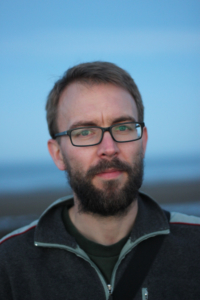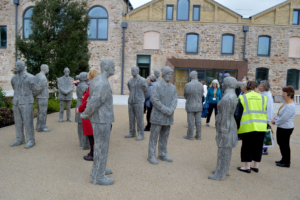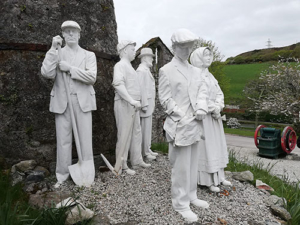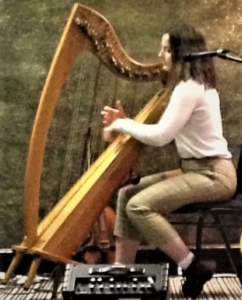The theme chosen by the Cornish Branch of the Celtic Congress for this year’s International Celtic Congress in Newquay was Recording our past to help inform our future. About 50 delegates attended from all six Celtic countries, and from elsewhere, and heard six speakers who explored the topic in a variety of ways.
On behalf of the Manx Branch, the copiously illustrated talk by James Franklin of Culture Vannin provided a practical summary, not just of how information could be recorded and presented, but of how it could be done in ways which intrigued and drew people in to find out more and particularly to become involved. Former International President, David Greaney of Wales, said that James’s talk had given him and a colleague positive ideas to implement in Wales. Grateful thanks are due to Culture Vannin for support in enabling James to travel to Newquay.
The development of modern technology has enabled ever more precise information to be recorded and to be presented in striking ways, such as moving through historic environments in virtual reality. This was demonstrated in the talk by Sue Fielding, the Senior Buildings Investigator at the Royal Commission on the Ancient and Historical Monuments of Wales. Modern technology also helps to identify the best means of preserving sites against erosion and other problems.
Cornwall is currently developing a brand new single home in the former Redruth brewery for what exist as separate archives. David Thomas, the Archivist at Cornwall Record Office, gave an outline of the many different objects in the Cornish archives and spoke about the new archive under construction. David Thomas also focussed on an interesting archive of J C Burrows’s photographs of Cornish miners and mining underground in the 1890s.
Both Brigitte Kloareg of Brittany and Cathlin Macaulay of Scotland looked at the recording of music. Brigitte showed how lyrics are subject to change as references are lost, and alternatives come in to try to make sense of them. Works may be subject to bowdlerisation, even where considered worth collecting. Lyrics often take precedence and tunes are lost. Some sound recordings had limited durability and many have been superseded, leaving redundant archives. Cathlin focused on the work of individual collectors, and went on to the development of technology which enabled the School of Scottish Studies, particularly under Hamish Henderson, to make exact transcriptions of a range of songs and spoken material and music in the field. Pieces from the archives have been published in modern formats.
A note of caution was sounded by Kerron O’Luain, the speaker from Ireland (though with a Manx mother, Pat Bridson, who used to teach in Peel). He spoke of the danger of revisionism. The suppression of ‘inconvenient’ facts and the promotion of preferred but spurious links could lead to an historic event being viewed in a distorted way, but may become the starting point for future reference.
There was an opportunity to visit the new Cornish archive site, Kresen Kernow, to see how things are being developed. In addition to use of the facilities as planned, staff there also spoke of how they have been seeing further opportunities emerge as the £20m project has unfolded.
Another visit was to the Wheal Martyn china clay pit, which is still being worked. The site also shows how the china clay industry developed and the techniques and technology involved. The area itself has now become pleasantly green and wooded, but formerly presented a stark, bare, dusty environment.
Storm Hannah was rather against a guided walk along the cliff tops, but Len Sheppard of the Old Cornwall Society’s Newquay Heritage Archive and Museum was a fount of knowledge in presenting an illustrated talk about Newquay and the area. It was him too who asked members of Cornish men’s vocal group, Oll an Gwella, to come and sing in the bar on Friday evening.
Further song came on Saturday evening with Cornish mixed choir Halwyn a Gan and Cornish dance music for the modern style nos lowen (noze looan) by Bagas Crowd on Sunday. There were also songs and the occasional tune from the Celtic countries at what were described as ‘informal’ sessions.
The final evening brought the International Concert. It was opened with aplomb by young Irish fiddle player and singer, Lauryn Bhreathnach, with a mixture of slow airs and dance tunes.
Songs of Brittany were beautifully performed, individually and as a duo, by Sylvie Guiner and Brigitte Kloareg.
A taste of the instrumental music of Wales was given by Rhiain Bebb on accordeon and triple harp.
Tony Kearney is well-known for his appearances on Scottish TV, but he brought Gaelic song from his native Barra and some bouncing puirt à beul to Newquay.
Mannin was beautifully represented by the award-winning harp playing of Mera Royle who played a mixture of modern compositions and traditional pieces.
The concert was brought to a close by young Cornish quartet The Woodcarts, who perform songs by guitarist Martha and her sister, fiddle/flute player Rosa, with friends Dan on percussion and Marcus on bass.




